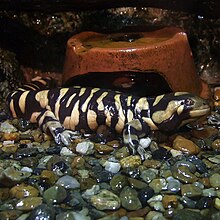Barred tiger salamander: Difference between revisions
→External links: updated link to photos |
|||
| Line 48: | Line 48: | ||
== External links == |
== External links == |
||
* [http://www.amphibiaweb.org/cgi-bin/amphib_query?query_src=aw_search_index&where-genus=Ambystoma&where-species=mavortium&rel-genus=equals&rel-species=equals Barred tiger salamander in amphibia.web database] |
* [http://www.amphibiaweb.org/cgi-bin/amphib_query?query_src=aw_search_index&where-genus=Ambystoma&where-species=mavortium&rel-genus=equals&rel-species=equals Barred tiger salamander in amphibia.web database] |
||
* [http:// |
* [http://sweb1.dmit.nait.ca/~amorozov1/petsalamander/photos.htm Barred tiger salamander in captivity] |
||
[[Category:Mole salamanders]] |
[[Category:Mole salamanders]] |
||
Revision as of 22:20, 27 January 2011
| Barred tiger salamander | |
|---|---|

| |
| Scientific classification | |
| Kingdom: | |
| Phylum: | |
| Class: | |
| Order: | |
| Family: | |
| Genus: | |
| Species: | A. mavortium
|
| Binomial name | |
| Ambystoma mavortium Baird, 1850
| |
Ambystoma mavortium, commonly known as the Barred Tiger Salamander, is a species of salamander found from southwestern Canada in British Columbia, Alberta, Saskatchewan and Manitoba, south through the western United States to Texas and northern Mexico.
Description

The Barred Tiger Salamander is one of the smallest water species, with a broad head and a small body. Its skin is dry and typically white, or black in color, with large yellow blotches. They are capable of growing to 2 in (5.1 cm) in length mouth to tail, but 1–1 in (2.5–2.5 cm) is more common. The tail of the salamander is also laterally compressed like all Tiger 's.
Behavior
Primarily nocturnal, Barred Tiger Salamanders are opportunistic feeders, and will often eat anything they can catch, including various insects, slugs, and earthworms. They are primarily terrestrial as adults, but their juvenile larval stage is entirely aquatic, having external gills.
Subspecies
There are five recognized subspecies of A. mavortium:
- Gray Tiger Salamander, Ambystoma mavortium diaboli (Dunn, 1940)
- Barred Tiger Salamander, Ambystoma mavortium mavortium (Baird, 1850)
- Blotched Tiger Salamander, Ambystoma mavortium melanostictum (Baird, 1860)
- Arizona Tiger Salamander, Ambystoma mavortium nebulosum (Hallowell, 1853)
- Sonoran Tiger Salamander, Ambystoma mavortium stebbinsi (Lowe, 1954)
In captivity
Tiger Salamanders are frequently kept in captivity. Barred Tiger Salamanders are legal to sell and are common in pet shops in the mid to southwest USA. Their large size allows for ease of feeding, and their hardy nature make them excellent captives. Their larval stage is often sold as fishing bait, marketed as mud puppies or water dogs.
Symbolism
The Barred Tiger Salamander is the State Amphibian of Kansas. The second grade class of 1993 of OK Elementary in Wichita, KS petitioned the governor and the initial idea for a state amphibian was presented to their teacher by Timothy Boyd and Kristofer Voorhees.
References
- Caudata Culture: Tiger Salamanders
- Amphibian Species of the World: Ambystoma mavortium
- "Ambystoma mavortium". Integrated Taxonomic Information System. Retrieved 10 July 2006.
- AmphibiaWeb: Ambystoma mavortium
